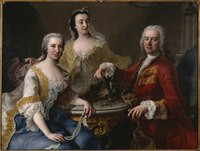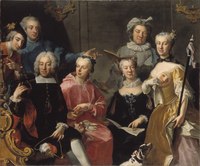Martin van Meytens
Swedish-Austrian painter (1695–1770) From Wikipedia, the free encyclopedia
Martin van Meytens (24 June 1695 – 23 March 1770) was a Swedish-Austrian painter who painted members of the Royal Court of Austria such as Marie Antoinette, Maria Theresa of Austria, Francis I, Holy Roman Emperor, the Emperor's family and members of the local aristocracy. His painting style inspired many other painters to paint in a similar format.
Life and career

Martin van Meytens was born and baptised in Stockholm, Sweden, son of the painter Martin Meytens the Elder, who had moved around 1677 from The Hague to Sweden. He went early in his career on an extended study trip. He visited London, Paris and Vienna, then he lived and worked for a long time in Italy (Rome, Turin). At the beginning he painted little enamel miniature portraits, and he changed to oil painting only around 1730, having settled in Vienna. Here he became very popular as a portrait painter in the circles of the court and the aristocracy. In 1732 he became a court painter, and in 1759 the director of the Viennese Academy of Fine Arts. Franz Xaver Messerschmidt was his protégé.[citation needed]
Aristocratic Baroque
Meytens was paid by Maria Theresa of Austria for opulent commissions. For example, in 1743 Maria Theresa waged war against her male counterparts in Europe, who entered a coalition. So Meytens had to paint, what was in the judgement of Alfred von Arneth an anachronistic "art of war" tournament motif, depicting Maria Theresa as warrior. This was only one instance of Meytens painting aristocratic Baroque culture in expensive splendidness.[1]
The Wedding Supper depicts the wedding of Princess Isabella of Parma and Joseph II, Holy Roman Emperor, 5 October 1760, at Hofburg Palace's Redoutensaele (Redoute Hall). The moment depicted is when the dessert is served, in the middle of the table is a garden made by sugar crust.[2]
Meytens has been credited with painting the European elite true to life. His most noticeable pupil was Joseph Hickel.[3]
Works
- ca. 1731; Kneeling Nun, Recto, (Nationalmuseum – Stockholm)
- 1741; Kaiser Franz I
- 1744; Maria Theresia, (Ghent Town Hall)
- 1745–1750; Familie der Grafen Pálffy
- 1750; Archduke Maximilian, (The Winnipeg Art Gallery)
- 1752–1753; Fam. Grill, ( Museum Gothenburg)
- 1750–1755; Maria Theresia als Herrscherin, (Schönbrunn Palace)
- 1754; Ksl. Familie, (Schönbrunn Palace);
- 1759; Maria Theresia, (Academy of Fine Arts)
Selected works
- Works
- Archduchess Maria Amalia of Austria (later Maria Amalia, Duchess of Parma)
- Archduchess Maria Antonia of Austria, 1767 (later Marie Antoinette, Queen of France)
- Maria Josepha of Bavaria, Holy Roman Empress
- Portrait of Emperor Francis I (workshop)
- Joseph de France and his Family
- Sackska family painting
- Carl Gustaf Tessin, Ulla Sparre of Sundby and Brita Stina Sparre
References
Other sources
External links
Wikiwand - on
Seamless Wikipedia browsing. On steroids.









